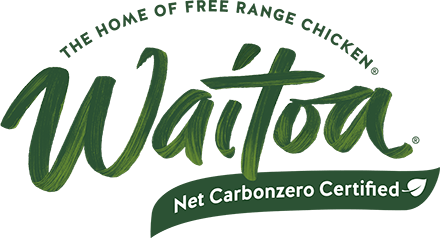Care, innovation and a passion for the best practice poultry farming has seen Waitoa grow to be one of New Zealand’s most popular free range brands. Our flocks lead a happy, healthy life. A life so good that we are SPCA® Certified for farmed animal welfare.
Where are Waitoa farms?
All of our farms are in the rolling green hills of the Waikato region in New Zealand.
Are there free range standards to follow?
Waitoa free range chickens have been farmed and audited against SPCA® Certified standards.
Are the chickens really free range and can they roam outside?
Yes, our chickens are free to roam outside during the day to scratch, peck and forage. As soon as our chickens are fully-feathered (at around 21 days), and it is safe for them to do so they can roam outside freely during the day. Our chickens can take shelter under trees and forage amongst natural vegetation. At night time, they are housed in large barns to keep them warm, comfortable and safe from predators.
What are the chickens fed?
Waitoa Free Range Chickens enjoy a nutritious diet of quality cereal grains, such as corn, wheat, sorghum, soyabean meals and are supplemented by vitamins and minerals to ensure optimum health and wellbeing.
Are there any pesticides used on the grounds where the chickens roam?
No, our farmers do not use pesticides in the areas where chickens roam.
Are the chickens given growth promoting hormones?
No, in line with the New Zealand poultry industry, our chickens are not given growth promoting hormones.
Do other wildlife or animals have access to the chickens?
The chickens are kept in well-fenced areas next to their barns and our farmers are responsible for their safety and well-being. At night time, Waitoa Free Range Chickens are housed in large barns to keep them warm and safe from predators.
Do the chickens eat outdoors?
Chickens are free to forage outdoors amongst natural vegetation around our farms, however their feed is provided inside the barn and is available to them at all times.
Are the chickens kept in cages whilst they are inside the barns?
Absolutely not. Our chickens are free to roam in fenced areas adjacent to their barn or can move around inside the barn at their leisure.
Can I visit a Waitoa Free Range farm?
For the safety of our chickens we follow strict biosecurity measures on all of our farms to minimise the possibility of disease in our flocks. Visits are on a strictly needs-only basis, and are generally limited to technical staff only.
Are chemicals used in processing the chickens?
The processing of Waitoa Free Range Chicken is strictly in accordance with New Zealand food safety and hygiene standards. Just as the water we drink is chlorinated to kill any bugs, so too is the water we use to wash the chickens during the cleaning process.
How do I safely prepare chicken?
Correct handling, storage and cooking are all equally important when cooking chicken.
1.Handling
- Do not wash fresh or frozen poultry.
- Wash hands and equipment thoroughly in hot soapy water after handling raw poultry.
- Do not place cooked product on plates used for raw poultry.
- Use separate boards for chopping raw poultry and other foods.
2.Storage
- Store raw poultry on the bottom shelf of the refrigerator below all other foods.
- Thaw frozen poultry completely in a refrigerator or defrost in a microwave prior to cooking.
- Do not thaw poultry on a bench or under running water.
- Once thawed, cook within 24 hours.
- Do not refreeze after thawing.
- Always cover raw poultry.
- Best practice – If refrigerating cooked poultry for later use, do so as soon as possible after initial cooking.
3.Cooking
- Poultry must be cooked thoroughly before eating.
- The internal temperature for bone-in poultry should be 82°C.
- The internal temperature for all other poultry should be 76°C.
- Best practice – Use a meat thermometer to check the internal temperature.
- A useful guide is to cook until the juices run clear. This does not remove the need to use a meat thermometer.
Refer to the Poultry Industry Association New Zealand website for more information on how to safely prepare chicken.
How do you safely reheat chicken?
Please refer the MPI's Tips for Food Safety.
What does Toitū netcarbonzero mean?
Toitū netcarbonzero certification required Waitoa Free Range Chicken to show how we had already reduced emissions across the supply chain and demonstrate what plans are in place to reduce emissions even further. This includes emissions from sourcing raw materials, manufacturing, distribution, packaging, cooking and washing the dishes at the end of the meal. Waitoa then measures, reports, and achieves annual carbon footprint reductions.
Where does Waitoa purchase its carbon credits from?
Waitoa has partnered with Toitū-approved local projects in Marlborough and offshore to offset unavoidable carbon emissions to achieve net-zero emissions.
Why do you use ARL logos on your packaging?
The purpose of using the ARL on our packaging is to inform the consumers through an easy-to-understand standardised system on what can and cannot be recycled. ARL also helps consumers to understand the role they play in enabling recycling by separating different materials, washing and drying, and dropping materials off at soft plastics collections. And most importantly, it removes confusion and prevents contaminated materials entering the recycling streams.
Why do you use plastic in your packaging?
Our primary concern when it comes to packaging is keeping food safe for you and your family, and plastic is one of the best food barriers available to do this.
We are constantly working on improving our packaging whether using more recycled content, or making the packaging more recyclable within the current recycling facilities across New Zealand. You can find out more about this on our sustainability page.
